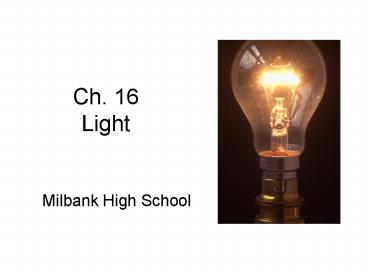Ch. 16 Light - PowerPoint PPT Presentation
1 / 16
Title: Ch. 16 Light
1
Ch. 16 Light
- Milbank High School
2
Sec. 16.1Light Fundamentals
- Objectives
- Recognize that light is the visible portion of an
entire range of electromagnetic frequencies - Describe the ray model of light
- Solve problems involving the speed of light
- Define luminous intensity, luminous flux, and
illuminance - Solve illumination problems
3
Let there be light!
- Main way we sense our surroundings
- Natural light
- Sun, flames, sparks, fireflies
- Artificial Light
- Bulbs, lamps, TVs, lasers
4
Light Fundamentals
- Electromagnetic Wave
- Stimulates the retina in the eye
- Wavelengths between 400 and 700nm
- Exact nature not fully understood
- Waves?
- Particles?
- 3.00 x 108 m/s
- c ?f
5
Ray Model
- Represents a straight-line representation of
light - Ignores wave properties
- Used to describe how light is reflected and
refracted
6
Sources of Light
- Luminous body
- Illuminated body
- Luminous flux, P
- lumen, lm
- Illuminance, E
- lux, lx
7
Luminous Intensity
- Luminous flux that falls on 1 m2 of a sphere 1 m
in radius - candela, cd (candle power)
- E P/4pd2
- E is illuminance
- P is luminous flux
- d is distance from surface
8
Questions
- How do we know that light travels through a
vacuum? - What color of visible light has the shortest
wavelength? - What are the units for
- Luminous intensity
- Illuminance
- Luminous flux
9
Sec. 16.2Light and Matter
- Objectives
- Explain the formation of color by light and by
pigments or dyes - Explain the cause and give examples of
interference in thin films - Describe methods of producing polarized light
10
Light and Matter
- Transparent
- glass
- Translucent
- Lamp shades
- Frosted light bulbs
- Opaque
- bricks
11
Color
- Spectrum
- Primary Colors
- Red, green, blue
- Secondary Colors
- Yellow, cyan, magenta
- White
- Same intensities of red, green, and blue
12
Colors Cont
- Complementary colors
- Yellow made from red and green light
- Yellow blue white
- Thus, yellow is the complementary color
13
Color by subtraction
- Dye
- Molecule that absorbs certain wavelengths of
light and transmits others - Pigment
- Primary Colors
- Absorbs one primary color from white light
- Yellow, cyan, magenta
- Secondary Colors
- Absorbs two primary colors
- Red, green, and blue
14
Formation of Colors in Thin Films
- Soap bubble, oily films
- Results of constructive and destructive
interference of light - Thin-film interference
15
Polarization
- The intensity of the light is reduced by half
- Light travels in two planes
- Polarizing material cancels out one of the planes
16
Review Questions
- What colors does white light consist of?
- Is black a color?
- Why are the insides of binoculars and cameras
painted black? - You put a piece of red cellophane over one
flashlight and a piece of green cellophane over
another. You shine the light beams on a white
wall. What color will you see where the two
flashlight beams overlap?































